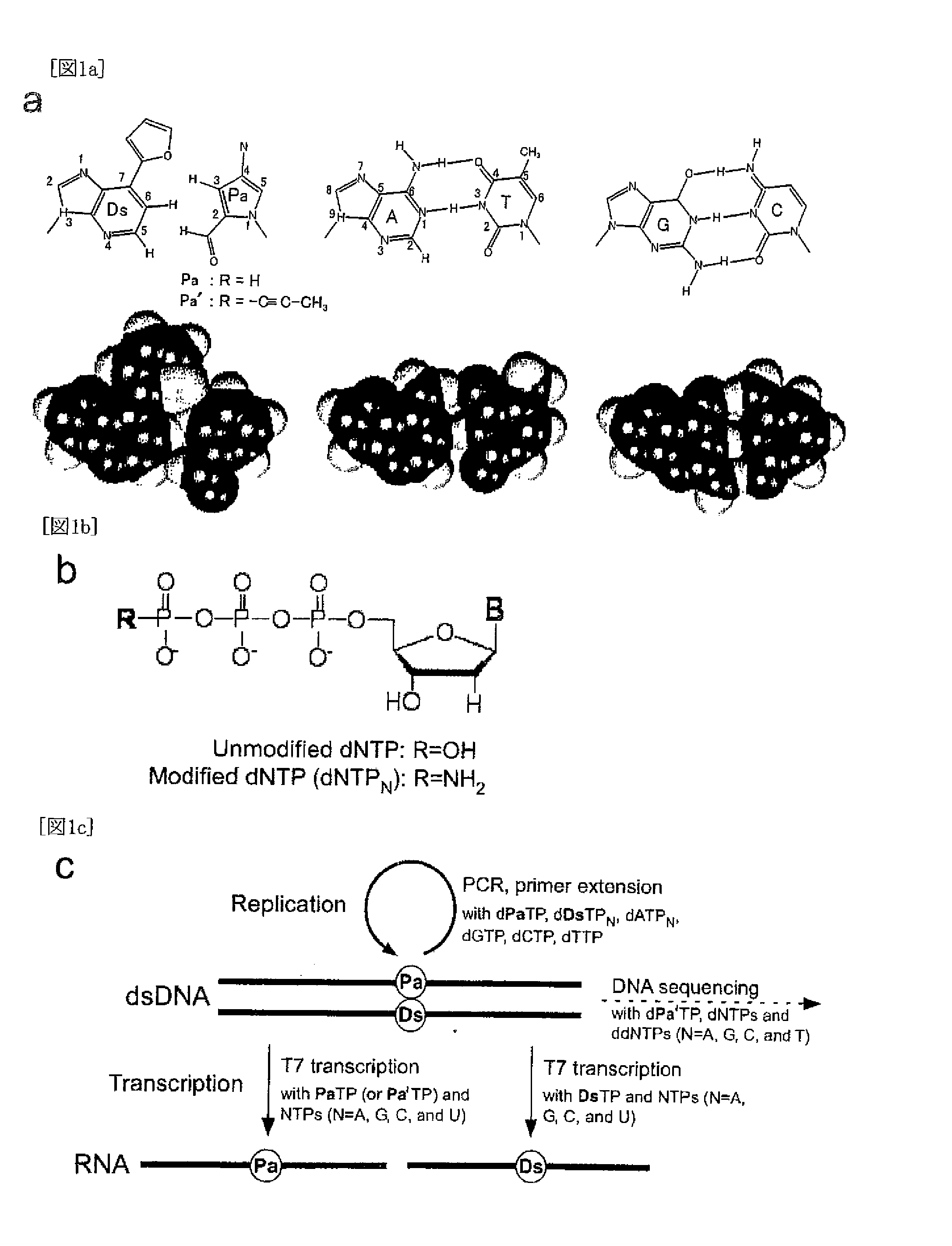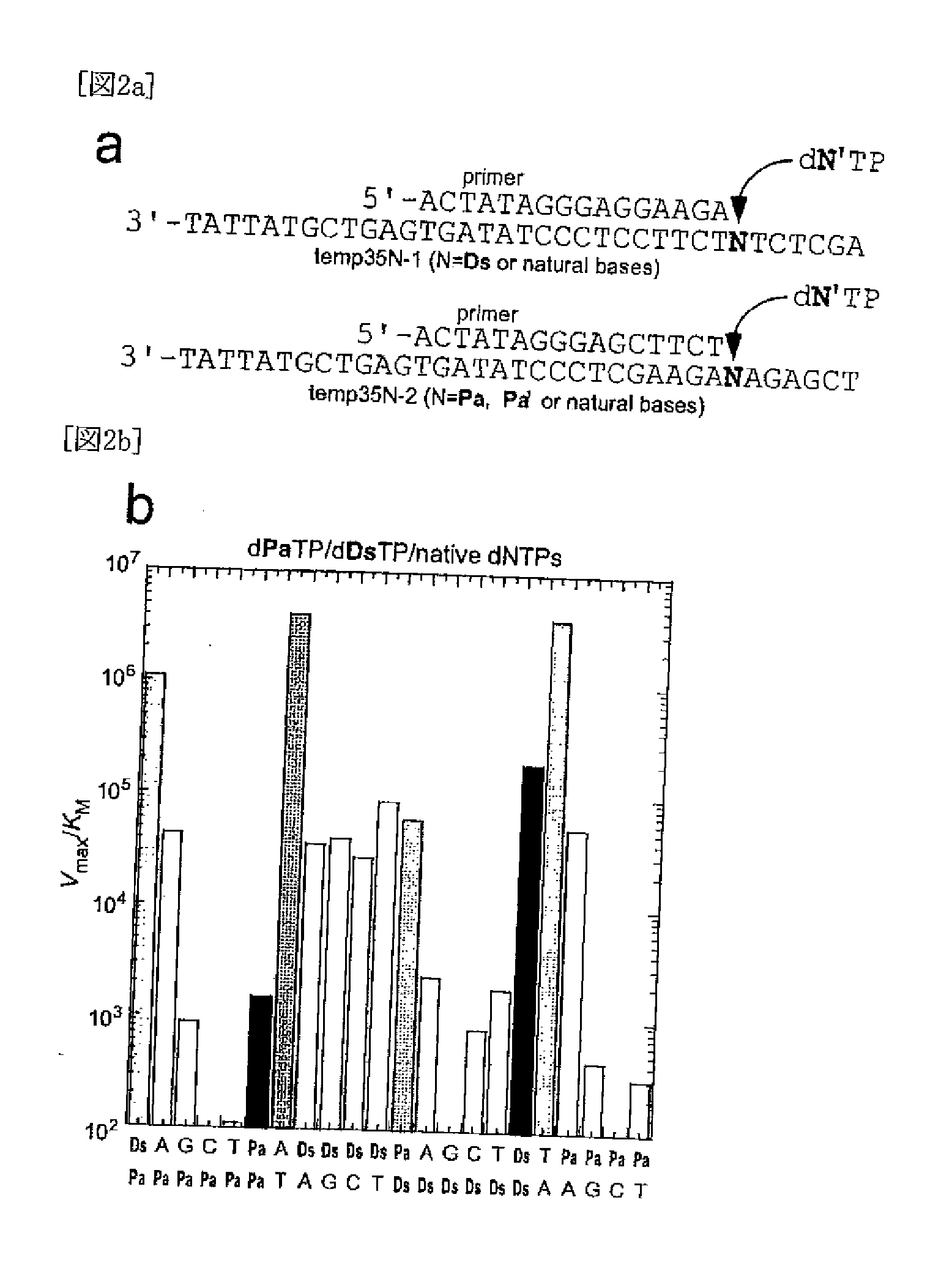Method for replicating nucleic acids and novel unnatural base pairs
- Summary
- Abstract
- Description
- Claims
- Application Information
AI Technical Summary
Benefits of technology
Problems solved by technology
Method used
Image
Examples
example i chemical synthesis-1
1. General Methods and Materials
[0451]All reagents and solvents were purchased from standard suppliers and were used without further purification. Two-dimensional thin-layer chromatography (2D TLC) was performed using 0.25 mm silica gel 60 plates containing a 254 nm fluorescence indicator (Merck) to monitor transcription reaction. 1H NMR, 13C NMR and 31P NMR spectra were recorded on JEOL EX270 and BRUKER nuclear magnetic resonance spectrometers (300 MHz and 600 MHz). Nucleoside purification was performed on a Gilson HPLC system equipped with a preparative C18 column (Waters Microbond Sphere, 150×19 mm). Triphosphate derivatives were purified with a DEAE-Sephadex A-25 column (300×15 mm) and an analytical C18 column (Synchropak RPP, 250×4.6 mm, Eichrom Technologies).
[0452]High-resolution mass spectra (HRMS) and electrospray ionization mass spectra (ESI-MS) were recorded on a JEOL HX-110 or JM700 mass spectrometer and a Waters micro mass ZMD4000 equipped with a Waters 2690 LC system, r...
example ii chemical synthesis-2
1. Synthesis of nucleoside derivatives of 7-(2-thiazolyl)-3H-imidazo[4,5-b]pyridine (Compound 4) (Dv) (FIG. 33)
[0532]The same procedure as shown in FIG. 22 for synthesis of nucleoside derivatives of 7-(2-thienyl)-3H-imidazo[4,5-b]pyridine (Compound 4 in Example I) (Ds) was repeated, except that 2-(tributylstanyl)thiazole was used in Reaction (a) for introducing a thiazolyl group.
[0533]However, with respect to amidite synthesis (g), 2-cyanoethyl-N,N-diisopropylamino chloro phosphoroamidite, diisopropylethylamine and THF were used in this example, although 2-cyanoethyl tetraisopropylphosphorodiamidite and 0.45 M tetrazole in acetonitrile were used in Example I-3(7) for synthesis of 7-(2-thienyl)-3-[2-deoxy-5-O-(4,4′-dimethoxytrityl)-β-D-ribofuranosyl]-3H-imidazo[4,5-b]pyridine 2-cyanoethyl-N,N-diisopropylphosphoroamidite (Compound 8). Although different reagents are used, the same amidite is produced.
2. Synthesis of Nucleoside Derivatives of 2-nitropyrrole (Compound 1) (Pn) (FIG. 34)...
example iii biological experiments
[0558]1. Procedures
[0559]In this example, the following procedures were used unless otherwise specified.
[0560]Single Nucleotide Insertion Experiment using KF exo−
[0561]The single nucleotide insertion experiment was performed as described in documents (Non-patent Documents 30-32). A primer (20-mer) labeled with 6-carboxylfluorescein at the 5′-end was annealed with template DNA (35-mer) by heating at 95° C. and slow cooling to 4° C. in 100 mM Tris-HCl (pH 7.5) buffer containing 20 mM MgCl2, 2 mM DTT and 0.1 mg / ml bovine serum albumin. The primer-template duplex solution (10 μM, 5 μl) was mixed with 2 μl enzyme solution of the Klenow fragment lacking exonuclease activity (KF exo−, Amersham USB). After the mixture was incubated for 2 minutes, each dNTP solution (3 μl) was added to this solution to start the reaction at 37° C. The amount of the enzyme used (5-50 nM), the reaction time (1-35 minutes) and the gradient concentration of each dNTP (0.3-1500 μM) were adjusted to ensure conditi...
PUM
| Property | Measurement | Unit |
|---|---|---|
| Temperature | aaaaa | aaaaa |
| Temperature | aaaaa | aaaaa |
| Volume | aaaaa | aaaaa |
Abstract
Description
Claims
Application Information
 Login to View More
Login to View More - R&D
- Intellectual Property
- Life Sciences
- Materials
- Tech Scout
- Unparalleled Data Quality
- Higher Quality Content
- 60% Fewer Hallucinations
Browse by: Latest US Patents, China's latest patents, Technical Efficacy Thesaurus, Application Domain, Technology Topic, Popular Technical Reports.
© 2025 PatSnap. All rights reserved.Legal|Privacy policy|Modern Slavery Act Transparency Statement|Sitemap|About US| Contact US: help@patsnap.com



